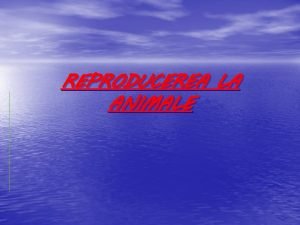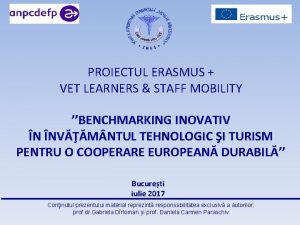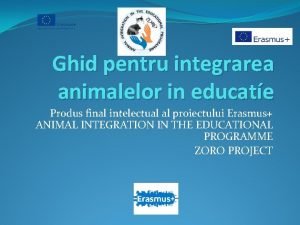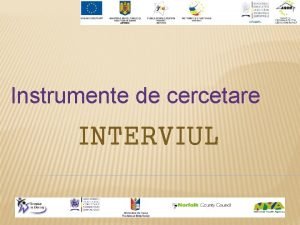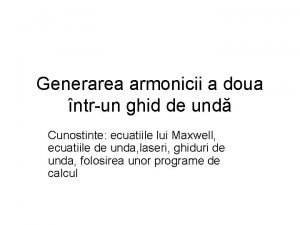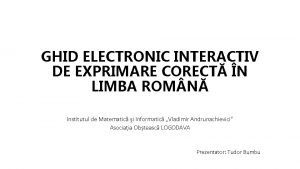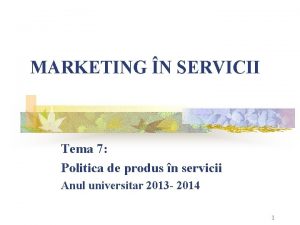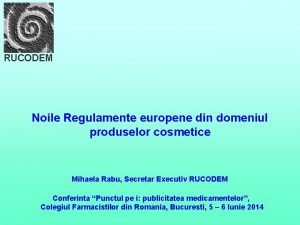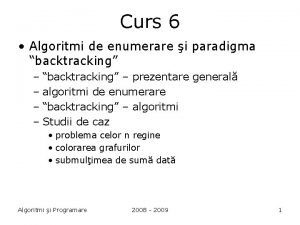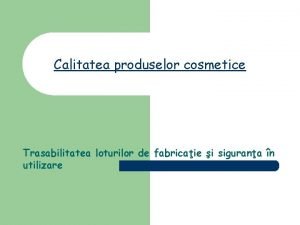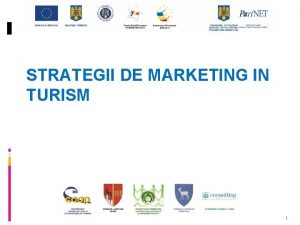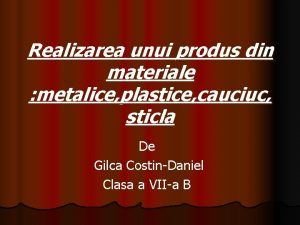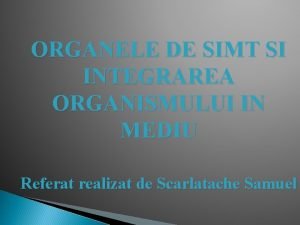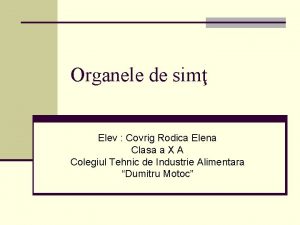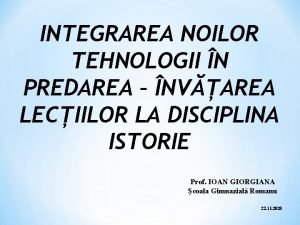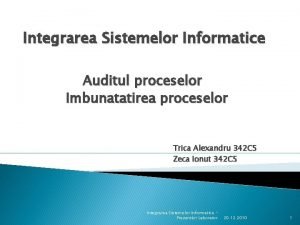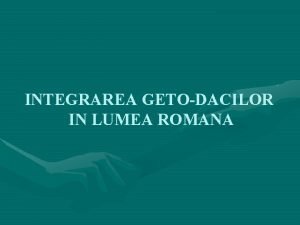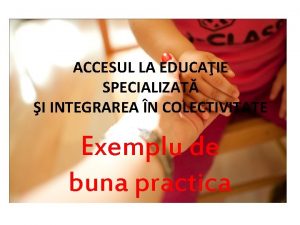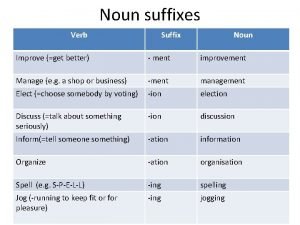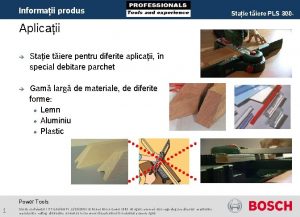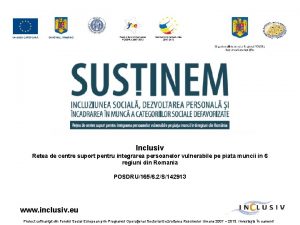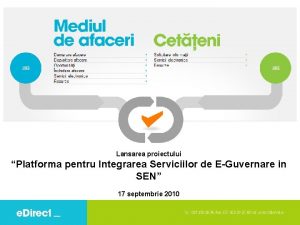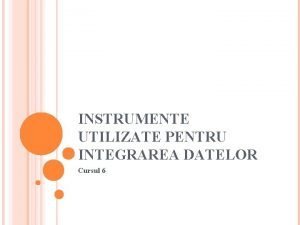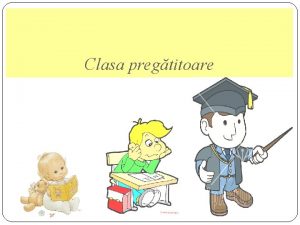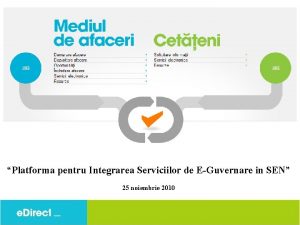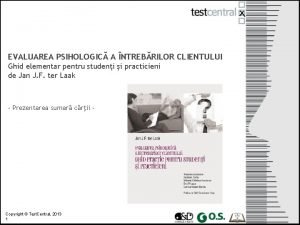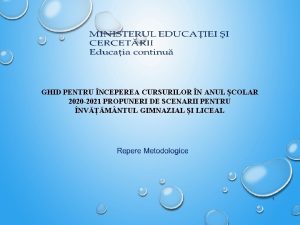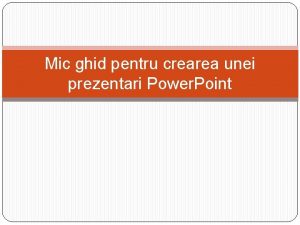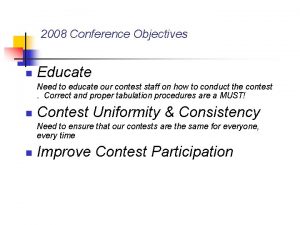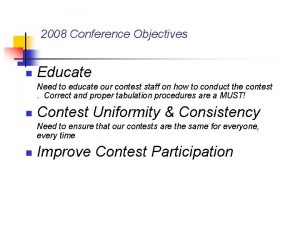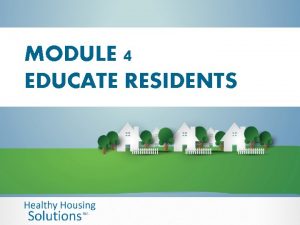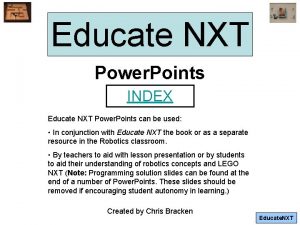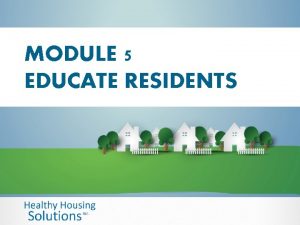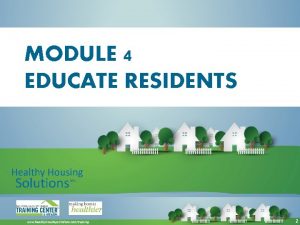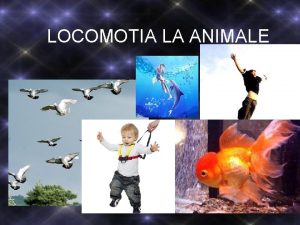Ghid pentru integrarea animalelor in educate Produs final


























- Slides: 26

Ghid pentru integrarea animalelor in educatíe Produs final intelectual al proiectului Erasmus+ ANIMAL INTEGRATION IN THE EDUCATIONAL PROGRAMME ZORO PROJECT

Structura ghidului �Explicatii despre proiect �Introducere in programele de Interventii Asistate de Animale- explicarea terminologiei folosite in proiect �Beneficii ale interactiunilor cu animale asupra omului �Evaluarea unui animal pentru a puta fi folosit in sedinte de terapie sau in sesiuni din scoli �Semnele de stres la animale �Riscurile asociate cu folosirea animalelor in sesiuni de terapie/la clase �Cele mai bune practici cu animale �Pregatirea animalelor pentru sesiunile de lucru

�Evaluare si masurarea rezultatelor �Concluzii �Referinte �Anexe( studii de caz, planuri de lectii, fisa de evaluare a unui caine, fisa de verificare a sanatatii animalului, libertatile fundamentale animalelor, semne de stre la animale, fisa de evaluare a riscurilor, fisa de ingrijire a animalelor adapostite in scoli �Anexa 10 -Brosura “Interactiuni Asistate de Animale

ANIMAL INTEGRATION IN THE EDUCATIONAL PROGRAMME ´´ZORO´´ Erasmus+project- ZORO Romanian case study- Scoala Gimnaziala Asau

General information �Session: reading to the rabbit �Student: Paul, aged 12 �Facilitator: Loredana( teacher, owner of the pet) �Assistant: Gabriela( school psychological counsellor) �Date: September 28, 2017 �Reference number: ASAU -PC-09 -16 �Nr of session; 2 out of 10 �Materials required: . The book Our speechless friends, by Emil Garleanu, worksheets, letter cards, pen and pencils, two bags for words, carrots, water, board.


Introduction/Background � Paul is student in our mainstream school but he has serious learning delays which made him fail in passing one school year. Although he is 12 years old, he is in the 4 th grade as he had to repeat the school year. He has dyslexia and cognitive impairments related to reading , recognizing sounds and letters, spelling and writing. He also experiences difficulties with staying focused on the task and collaborating both with peers and with the teachers. The school psychological counselor thinks that Paul may be helped in improving his reading skills, as accuracy, fluency and understanding the meanings, as well as associating letters and sounds when reading, by making him aware of them during the interaction with an animal. � Paul rarely interacts with peers, he is quite isolated and lonely, rarely is attracted by a school activity because he experiences issues with understanding the task he is required. Paul’s parents are also aware of Paul’s learning and understanding issues. He interacts with adults and cooperates when is asked individually, but he has the tendency to avoid questions or his answers are very short. Paul is very fond of animals and likes to take care of them.

Key goals and benefits of the session �Cognitive- Reading in Romanian (he has difficulties in reading and linking graphemes with phonemes as well as integrating sounds, letter patterns and meaning together, in order to to decode the message of a text) �Psychological-trigger memory and allow reminiscence(he encounters issues in remembering meaning of words and spelling) �Emotional- enhance independence(fulfill practical activities and take decisions of his own) �This session had cognitive, psychological and emotional benefits


Animal selection, planning and preparation �The team of teachers from our school and the school counselor thought about the most suitable animal which could help Paul improve his reading and literacy skills and the common decision was to use a rabbit. The school rabbit Fluffy which was domesticated and had a good relationship with children, as it was used in other activities at classes. It was prepared for the reading sessions with Paul. It was desensitized by gradual exposure to the school environment and taking part in more activities with different groups of children from our school at different school subjects.


Activities/ Methodology � Paul was asked by the school counselor how he was feeling. Paul said he was happy and can hardly wait to see Fluffy again. Fluffy, the rabbit, was brought into the classroom in his cage who was placed together with the cage in front of him on the desk. Paul was encouraged to imitate the quick movements that Fluffy made with his nose which the boy considered very funny. The facilitator took the rabbit out of the cage showing Paul how to handle it. The boy was allowed to pet the rabbit and then take it on his arm, gently. He was asked how he feels and how he feels about the rabbit. Paul said that the rabbit was soft and cute and he liked it. � Paul was told by the facilitator that it was reading time and introduced the excerpt of the story which Paul was already familiar with from the previous session. He was asked if he remembers any information from that text, characters, some actions, etc. Then he is asked to read the text again to Fluffy which will listen to him carefully. The number of reading mistakes were recorded on the graph comparing the results with those of the initial assessment and the first session. Every time the boy misread a word he was encouraged to correct himself. On a board the boy got a rabbit smiley face

�Paul was allowed to pet the rabbit and play a little bit with him on the floor. Then the boy and the facilitator went outside in the school garden and cleaned the cage. �After that Paul was congratulated for how well he did in the session asked about his state of well-being and asked if he would like to do some other reading sessions with the rabbit. Paul asked positively to this, saying that he can hardly wait to do this again. �Paul washed his hands and went to his classroom.


Results of the session- reading accuracy Task Number of misread words in Session one Number of misread words in Session twoat the beginning of the session Reading accuracy 30/100 words and fluency 20/100 words 10/100 words Reading time 3. 30 min 3 minutes 10% Improvement between sessions Number of misread words at the initial assessment 4 min.

Reading accuracy 120 100 80 correct words 60 errors 40 20 30 20 10 0 Initial assessment First session Second session

Improving memory and allow reminiscence Trial 1 2 Recognizing right initial vowels and consonants out of 10 Write words Read previously correctly with the misreads words given letters out of correctly out of 10 ten Memorize words 7 spelling 6 3 8

re-reading words mistakes spelling right answers recognize initial letters 0 1 2 3 4 5 6 7 8

Enhance independence Reading correct amounts Preparing correct amounts out of 5 without trainer’s of food and drink help independently and feeding it ( no help) Number of unprompted 3 decisions when interacting and caring Fluffy 4

Enhance independence 4 3. 5 3 unprompted reaction 2. 5 supported interventions 2 1. 5 1 supported interventions 0. 5 0 reading amounts preparing food and feeding unprompted reaction


Discussions on the session � As we can see, Paul has made improvements when comparing to the previous sessions in all key goals. The improvements were of 20% from the previous session. This means maintainable progression which lead the next steps to be taken. �Reading accuracy � Although Paul still made some reading mistakes, he made improvements from the previous sessions. If the initial evaluation shows 30 mistakes out of 100 words in reading the given paragraph from the short story, the first session the mistakes were only 20 and in the second session there were just 10 of them. After completing the reading and spelling activities assisted by the animal, Paul was able to spell, write and read correctly 8 out of 10 words that he experienced issues of reading so far. This means that Paul can go on with the reading sessions with the next paragraphs from the short story from the target book. Paul felt relaxed, smiling and willing to make improvements while reading to Fluffy , as the animal interaction offer non-judgmental support for him and he doesn’t feel so embarrassed when making mistakes as he used to be when usually reading in class.

�Improving memory and allow reminiscence � After reading the text Paul was asked to recognize sounds and letters and make correlations between them in order to become more aware of the meaning and spelling of words and remember them easily when he sees them again. He operated with such terms as vowels and consonants, practicing to recognize them in other words. He recognized 7 of 10 initial vowels/consonants in the given words and he mistook three of them. �Enhance independence � Paul was asked to read information on the sheet about the rabbit’s bodily features and his diet. After that he had the freedom to prepare the rabbit the correct amount of water to fill the drinker and to cut the pieces of carrot and count them. Then he was encouraged to go outside and clean the cage and finally play with the rabbit. This made him proud and more interested in engaging in the activities because he was allowed to take his own decisions.

Conclusions �It can be observed that the key goals for Paul were improved this second session. At the beginning of the session he misread 10 words comparing to 30 at the initial assessment, so the improvement made was of 20%. After practising words reading, spelling and writing he made an improvement of 80% as he managed to re-read correctly 8 of the 10 words he practiced with. The progress and the observation of the activities that worked with Paul’s learning were used to carefully plan the next sessions. Paul will also be assessed during the other classes with his classmates without animal assistance in order to observe improvements in reading and emotional response.


Thank you for your attention
 Scrie aproximarea prin adaos a numărului
Scrie aproximarea prin adaos a numărului Lanțurile trofice
Lanțurile trofice Reproducerea la pasari
Reproducerea la pasari Animale care nasc pui vii
Animale care nasc pui vii Locomotia la om
Locomotia la om Ghid erasmus 2018
Ghid erasmus 2018 Ghid erasmus
Ghid erasmus Ghid completare declaratie avere
Ghid completare declaratie avere Ghid de interviu definitie
Ghid de interviu definitie Unda armonica
Unda armonica Alege forma corectă de exprimare
Alege forma corectă de exprimare Politica de produs
Politica de produs Rucodem
Rucodem Produs turistic de tip sejur
Produs turistic de tip sejur Colorarea grafurilor
Colorarea grafurilor Etapele lansarii unui produs pe piata
Etapele lansarii unui produs pe piata Calitatea unui produs
Calitatea unui produs Analiza swot agentie de turism
Analiza swot agentie de turism Operatii de finisare a materialelor metalice
Operatii de finisare a materialelor metalice Prezbitismul
Prezbitismul Defectele ochiului
Defectele ochiului Integrarea noilor tehnologii in educatie
Integrarea noilor tehnologii in educatie Integrarea sistemelor informatice
Integrarea sistemelor informatice Integrarea dacilor in lumea romana
Integrarea dacilor in lumea romana Integrarea copiilor cu autism in invatamantul de masa
Integrarea copiilor cu autism in invatamantul de masa Educate women
Educate women Suffix of improvement
Suffix of improvement


